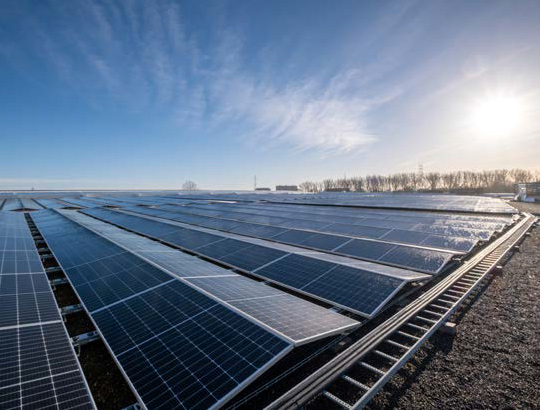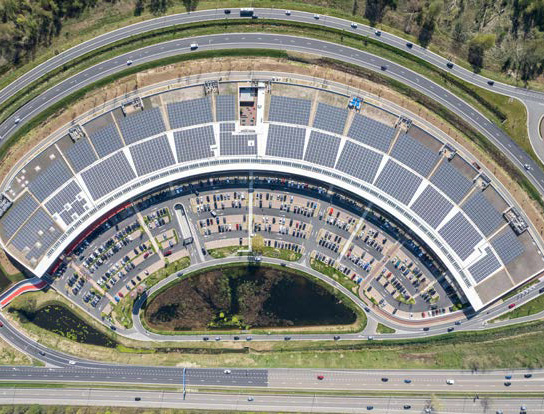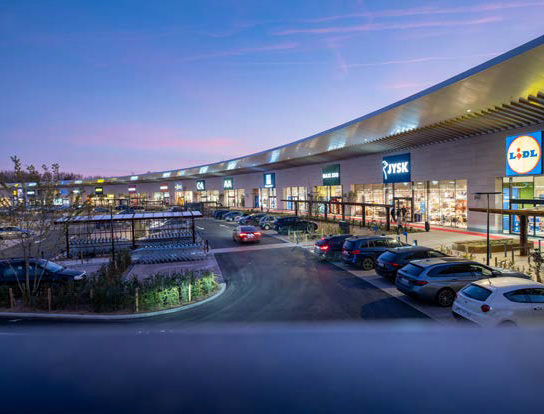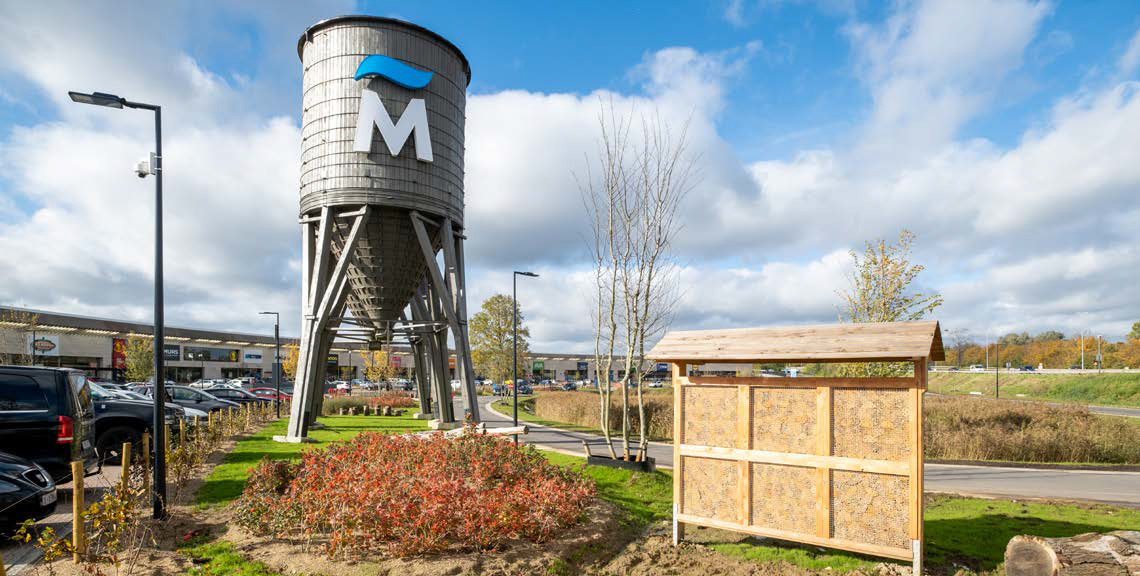RETAIL PARKS
Building europe’s most
sustainable retail park portfolio
WHY DEVELOPING WITH AN ESG LED ETHOS IS A SOUND INVESTMENT CHOICE
OUR APPROACH TO DECARBONISATION
Over the past 5 years, it has become impossible to ignore the importance of ESG factors both in retail and real estate, with sustainability moving from a nice-tohave to a must-have for all stakeholders.
Today, sustainability and ESG, alongside location, occupiers, building scale and building quality are now the key factors in property value and performance, and this importance will only increase over time. From a fund management perspective, the drivers are primarily to protect the medium to long-term value of the portfolio, while adding value and acting in a socially responsible manner.
We recognise that achieving sustainable urban growth is an essential and pressing issue. This is not without its challenges of course, but considerations concerning ESG factors play a crucial role in being a responsible fund advisor, and are a key driver in creating long-term value for all our stakeholders and for society by making our business and our managed assets future-proof.
As part of our commitment to achieve net-zero carbon across our real estate portfolio by 2035, we have deepened our net-zero strategy and goals as we believe carbon counting and the focus on carbon will define the decade ahead.
Achieving net-zero for the industry will not be a walk in the park. However, we believe that by pursuing change and embracing innovation, our industry can decarbonize and move from being part of the problem to being part of the solution. To close the huge gap between current emission levels and the reductions needed to meet the Paris targets, the industry must act now.
In the past 10 years Mitiska REIM has built, on behalf of funds, a portfolio of 91 properties representing 1,100,000 m2 gross leasable area across 10 European countries. We’re growing and developing quickly and recognise the need to minimise environmental impact while optimising financial returns. This is an entirely possible proposition. In October 2021 we opened Europe’s most sustainable retail park, Malinas, in Mechelen, Belgium, using a model we plan to roll out to other developments. So, how are we transforming the out-of-town real estate market?
BUILDING SUSTAINABLY
A key starting point is to design and build sustainably from the outset. While people may believe that creating a sustainable building is more expensive, it is in fact significantly cheaper than attempting to put “green lipstick” on an existing building.
In order to incorporate sustainability in all aspects, it is critical that all parties involved in the construction – architects, engineers, contractors, and developers – get together early in the process so that there is a clear consensus from the start that creating a green building is the main goal. Not doing so means that projects may not be able to take advantage of some of the most powerful aspects of green design, such as passive components. These passive components include site selection, such as locating new buildings near brownfield sites and mass transit, and factors such as orienting buildings east-west for shading and thermal insulation.

There are a number of useful tools to ease the process. For example, certification guidelines such as BREEAM or LEED can help in this process as well as BIM (Building Information Management) modelling to create a detailed digital representation of the project can help with clash detection, cost calculation, procurement, information gathering, communication, etc. Moreover, all building information is stored digitally forever in BIM which is a helpful asset management tool in the future, should the building need to be refurbished or demolished.
When it comes to design, buildings should be designed to minimize embodied and operational carbon. For embodied carbon, one can look at the materials used, drawing information from green labels, the raw materials used, the production process, and transportation needed.

Perhaps more important is designing a flexible building that could be used for different purposes in the long run. The flexible, modular design of retail parks, urban logistics and multi-let light industrial, which we collectively call ‘convenience real estate’, is a good example. To minimize operational carbon, we have opted for a net-zero operational design (solar panels, electric heating and cooling systems, making optimal use of daylight, no gas etc.).
During construction, we look at different transport modes, optimization of deliveries, minimization of transport, or generation of green electricity on-site, just to name a few. To achieve this, good communication with neighbours, the city and other stakeholders is important to get everyone involved and onboard.
By making good sustainability choices early in the process, the benefits are reaped through lowering operational
carbon and by making the retail park net-zero carbon, generating onsite energy, making full use of daylight, removing the use of any fuels, etc.
Malinas Retail Park has an expected energy consumption of only 116 kWh/m2 GLA, and plans to use 100% renewable energy. The park does not consume any fossil fuels. About 65% of all electricity comes from the solar panels installed on the roof that generate approximately 2.3 MWh, as well as a battery storing the generated electricity. The remaining electricity is renewable electricity from the grid.

Thanks to the onsite energy generation through the solar panel installation and the use of 100% renewable grid energy, Malinas achieves a 0 kgCO2/m2 greenhouse gas intensity. As a result, the CRREM tool indicates that the retail park has a greenhouse gas consumption below the 1.5°C global warming target as set out by the Paris Climate Agreement.
These factors have made Malinas the most sustainable retail park in Europe and the first retail park building to be net-zero carbon in operation. Our aim is to adopt this model across our portfolio going forwards.
CREATING GREENER OPERATIONS
In order to comply with the UN Paris Agreement, additional ESG initiatives are often required on top of the legislation. These initiatives are encouraged by private and public financiers, for example in the form of
green loans. By committing to ESG, one can therefore win on several levels.
Reducing the cost of capital is a clear win. Investment vehicles with green assets can now attract more capital at a lower cost. Investors attach a brown discount to buildings that do not meet established sustainability criteria. This trend may be strengthened by the EU taxonomy regulation, which will increase market transparency and make it easier for investors to establish whether a new construction project, rehabilitation, or acquisition of property is ‘green’ or ‘brown’.
As a developer, we feel the responsibility to invest in and develop future-proof assets that in turn create green operations. Avoiding a climate catastrophe is now the greatest global priority. With buildings contributing to up to 40% of global greenhouse gas emissions, the built environment sector has a pivotal role to play in decarbonising and meeting the commitment to the UN Paris Agreement.
Improving operational efficiency and investing in energy efficiency also helps reduce the risk of volatile energy prices and reduce utility costs. The prospect of lower energy costs may mean tenants are willing and able to afford to pay more rent, which creates an economic incentive for owners to invest in operational efficiency. The anticipated introduction of carbon taxation is also likely to increase the cost of energy consumption in the coming decade.
Moreover, governments have set climate policy objectives that, if implemented, will transform how energy is produced and consumed. Building regulations are emerging that set requirements for disclosing and reducing energy use in buildings and reducing related carbon emissions.
As new regulations come into force, assets that do not meet the required levels of energy performance have several potential risks, such as becoming stranded, seen as unattractive to occupiers, and losing value, all of which have the potential to adversely affect returns. As investors and real estate owners, we have a responsibility to future-proof our real estate investments, and to ensure they are resilient and able to adapt to both climate-related transition and physical risks.
The built environment’s role is to support people in their everyday activities, providing workplaces, homes and amenities. The role of a responsible real estate investor is to provide good quality spaces that support both human wellbeing and are carbon-conscious, contributing to the health of people, society, and the planet.
“Investors or developers who choose not to have green or net-zero carbon buildings or ignore certification will increasingly find that potential tenants and investors are less attracted to their buildings.”
PUTTING A PRICE ON SUSTAINABILITY
While green isn’t free, it doesn’t have to break the budget when compared with conventional buildings on a first-cost basis. Sustainability isn’t simply an amenity or signifier of corporate responsibility, but a core feature of the financing plan.
At our Malinas development, the additional cost to obtain a netzero carbon building in operation and the BREEAM in-use Excellent certification was about 6.5% of the total €32.5 million construction cost. The biggest single investment in sustainable features was the solar panels and battery, at around €1.5 million. However, the payback period of these solar panels and battery is calculated at less than 4 years.
The cost of a BREEAM-certified and net-zero carbon building in operation should also be considered a marketing cost, not just a construction cost, as certification increases awareness of the building, leading to publicity and tenants who move in because the building is green. Investors or developers who choose not to have green or net-zero carbon buildings or ignore certification will increasingly find that potential tenants and investors are less attracted to their buildings.
Increasingly, funding sees lower interest rates for green buildings, for example through green loans, compared to the rates offered for conventional buildings, making bank financing easier and saving money over the life of a loan and improving the financial returns of the asset. Investors and developers, therefore, need to consider the life cycle impact of investments in green building elements because they will, in many instances, justify higher initial costs. For example, when energy and water costs are considered over the life of a building, they can help justify green purchasing decisions.
Recent research has found that since 2011, commercial buildings in Central London with a BREEAM rating Very Good or higher achieved a selling price on average 8% higher. If we assume this green premium also extends to other sectors, the initial price of sustainability becomes attractive.
It is therefore clear that the combination of political, societal, and market forces are increasing in momentum in favour of sustainability. By building sustainably, creating greener operations and budgeting in sustainable measures from the outset, investors can reap the benefits of what is a sound investment choice.





